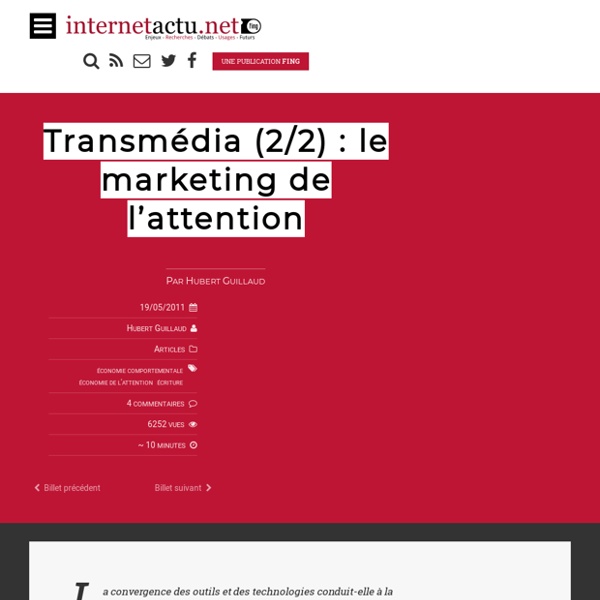



http://www.internetactu.net/2011/05/19/transmedia-22-le-marketing-de-lattention/
Related: transformTransmedia Storytelling By: Lauren Richardson (@r_lauren13) According to Carri Bugbee, transmedia consists of the technologies and processes that allow connections and interactions between fans, content creators and distributors of video content. Henry Jenkins in his weblog, Confessions of an Aca-Fan, further explores the basics of transmedia with an outline on his blog called “Transmedia Storytelling 101″. Here is a summary of some of Jenkins’ transmedia basics: Virtual Reality and Learning: The Newest Landscape for Higher Education When you think of higher education, chances are that virtual reality is not something that immediately comes to mind. In recent years, online learning has changed the face of education by becoming a supplement to traditional methods, allowing people to learn at a distance, on their own time and at their own pace. It has become a powerful tool for educators to expand their reach while providing students with a way to get an education without having to step foot into a classroom. Despite these advantages, online education has proven to be a double-edged sword.
New Infographic: The Brandsphere by Brian Solis and JESS3 Brian Solis Social networks and channels present brands with a broad array of media opportunities to engage customers and those who influence them. Each channel offers a unique formula for engagement where brands become stories and people become storytellers. Using a transmedia approach, the brand story can connect with customers differently across each medium, creating a deeper, more enriching experience. Transmedia storytelling doesn’t follow the traditional rules of publishing; it caters to customers where they connect and folds them into the narrative. ‘s insight: Infographie Nouveau: Le Brandsphere par Brian Solis et JESS3 Brian Solis. The Three Ages of Consciousness of Storytelling - Yorke Communications Who doesn’t like a good story? None I guess. A good story is often, a story narrated well. A harder push would go like this. It is not the story, but how we narrate it. That is storytelling.
5 Tips for Transmedia Storytelling : Felicia Pride Here’s an excerpt from a great article by Margaret Looney about transmedia storytelling. She mentions pride collaborative and the story innovation event we organized during DC Week. Check it out: With readers juggling their tablets, mobile phones, laptops and more as they consume the news, journalists have an opportunity to create a new kind of story. How Fairy Tales Invite Children to Think Harder and Smarter Take a story, turn it into something larger than life, add a touch of magic, let it simmer for a few centuries, and presto! You have a fairy tale. With their high coefficients of weirdness, these stories — less about fairies than about monsters and wild things — haunt our collective cultural imagination.
Transmedia storytelling "Transmedia" redirects here. For a related process, see Transmediation. Transmedia storytelling (also known as transmedia narrative or multiplatform storytelling, cross-media seriality[1] etc.) is the technique of telling a single story or story experience across multiple platforms and formats including, but not limited to, games, books, events, cinema and television. The purpose being to not only reach a wider audience by expanding the target market pool, but to expand the narrative itself ([2]). Henry Jenkins, an author of the seminal book Convergence Culture warns that this is an emerging subject and different authors have different understanding. Story Science Finally we have come to part 3 of our 3-part article series on Short Form Storytelling. If you missed out on the earlier installments, be sure to read Part 1: One Story, One Idea here and Part 2: Compression, Compression, Compression. Previously we discussed the different ways in which you can compress elements in your story to make it denser and more efficient. Now we are going to discuss the three main categories of compression and how each applies to storytelling. Compression falls into three basic categories: (1) Structure (2) Character, and (3) Text, with Structure being the most basic of the three and Text the most involved. Within each category are five points, or ways, in which to utilize compression in that category.